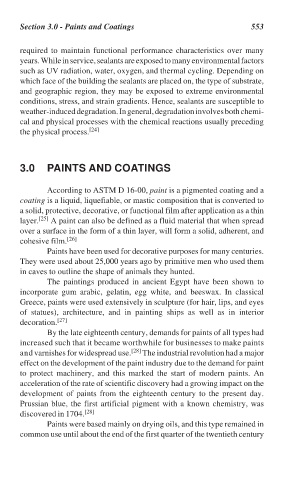Page 583 - Handbook of Thermal Analysis of Construction Materials
P. 583
Section 3.0 - Paints and Coatings 553
required to maintain functional performance characteristics over many
years. While in service, sealants are exposed to many environmental factors
such as UV radiation, water, oxygen, and thermal cycling. Depending on
which face of the building the sealants are placed on, the type of substrate,
and geographic region, they may be exposed to extreme environmental
conditions, stress, and strain gradients. Hence, sealants are susceptible to
weather-induced degradation. In general, degradation involves both chemi-
cal and physical processes with the chemical reactions usually preceding
the physical process. [24]
3.0 PAINTS AND COATINGS
According to ASTM D 16-00, paint is a pigmented coating and a
coating is a liquid, liquefiable, or mastic composition that is converted to
a solid, protective, decorative, or functional film after application as a thin
layer. [25] A paint can also be defined as a fluid material that when spread
over a surface in the form of a thin layer, will form a solid, adherent, and
cohesive film. [26]
Paints have been used for decorative purposes for many centuries.
They were used about 25,000 years ago by primitive men who used them
in caves to outline the shape of animals they hunted.
The paintings produced in ancient Egypt have been shown to
incorporate gum arabic, gelatin, egg white, and beeswax. In classical
Greece, paints were used extensively in sculpture (for hair, lips, and eyes
of statues), architecture, and in painting ships as well as in interior
decoration. [27]
By the late eighteenth century, demands for paints of all types had
increased such that it became worthwhile for businesses to make paints
and varnishes for widespread use. [28] The industrial revolution had a major
effect on the development of the paint industry due to the demand for paint
to protect machinery, and this marked the start of modern paints. An
acceleration of the rate of scientific discovery had a growing impact on the
development of paints from the eighteenth century to the present day.
Prussian blue, the first artificial pigment with a known chemistry, was
discovered in 1704. [28]
Paints were based mainly on drying oils, and this type remained in
common use until about the end of the first quarter of the twentieth century

